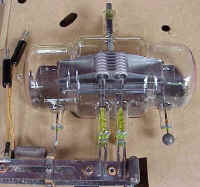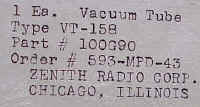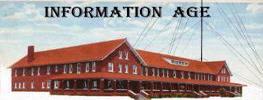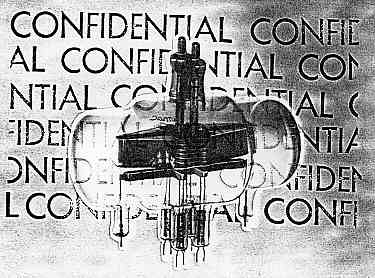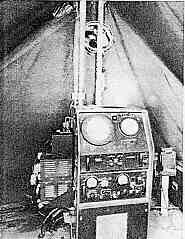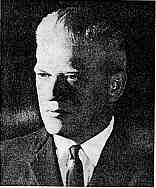![]()
|
This tube shown above is from the SMECC Collection
E. Hunter, WECT of Wimington, NC
sent this article to InfoAge - THANKS!!! THE YOUNG
RADIO AMATEUR saw the dull glint of glass in the bottom of the dusty box and
immediately plunged his hand into the receptacle, searching for the unknown
object that caught his attention. Grasping something, he slowly drew forth
a curious, large misshapen radio tube. Holding the dusty object up to the
bare light bulb dangling from a faded sign that read "UR CHOICE -
29c," he examined his find carefully. Puzzled, he turned to the
proprietor. "Hey, Sam! What do you know about this tube? Can I
use it on two meters?" |
||||
| WHERE SHALL WE start the story of the curious tube?
On a June morning twenty years ago in Normandy? Or before that, at
the Panama Canal, or years later on the slope of a numbered hill in Korea? It's a strange tale of a unique tube, an Army major and American ingenuity-a true story whose ob- solete residue was finally found by the inquisitive amateur in a surplus shop. Panama, 1940: America is not yet at war, but it is obvious to some that we soon will be. The Panama canal is a tempting and vulnerable target from the air. Radar, the radio eye, had been invented a few years before, but the only available equipment worked on the relatively low frequency of 110 megacycles, and then not very well. The safety of the canal could not be trusted to this primitive, unsensitive gear which showed an almost complete blindness in detecting low-flying airplanes. A decision is made to construct a small number of radically new and powerful radar sets capable of locating and detecting small planes, and to put these sets aboard picket ships located in the approaches to the canal. Laboratory ex- |
periments show that a good frequency for the new sets would be 600
megacycles, but no available tubes can produce the required power at
what was then regarded as an unusually high frequency. By a stroke of fortune of the kind that often changes history, a radar tube is invented by young Major Harold Zahl of the Army Signal Corps that can produce the power required. A prototype of the vital search radar employing the major's radically new tube is to be secretly built and tested as fast as humanly possible. On the M.S. Nordic off the New Jersey coast: The vessel is equipped with the new radar, and testing is going forward. Suddenly, a German submarine, intent on spying, surfaces close by. It does not go unnoticed, and as the sub's periscope turns, it sees a destroyer closing in together with a blimp overhead, both carrying depth charges. The sub crashdives as the depth charges drop. The new radar and those aboard the Nordicshaken up by the explosions-are safe. The tests continue. The search radar can detect a single bomber over one hundred |
|||
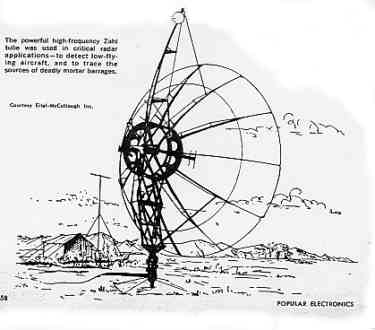
The
powerful high-frequency Zahl tube was used in critical radar applications-to
detect low-flying aircraft, and to trace the sources of deadly mortar barrages.
58
| miles away with the radar antenna mounted only fifteen feet
above the surface of the water!
THE SECRET, revolutionary canal radar
equipment was so successful that the Air Force asked the Signal Corps to
repackage the equipment into a lightassault type radar which could be
airlifted to a battle zone and then hand-carried to the front. A
prototype of the repackaged radar was built in February, 1943. To prove
it was air-transportable, the unit was loaded aboard a. bomber at the
Newark (ICJ.) airport and flown to Florida. It was up and in operation
four hours after it arrived at Orlando. The AN/TPS-3, known as
"Tipsy Three" is shown below installed in a tent. It was the
first radar set to operate at high power in 600-megacycle range. |
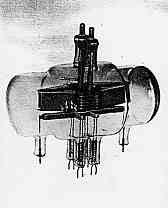
The Zahl tube and its inventor, Dr. Harold A. Zahl, now director of the Army's Research and Development Laboratories, Ft. Monmouth, N.J. The radically new tube-four triodes in parallel with tuned plate and grid lines to make it an oscillatormarked a point of departure for modern tube designs containing resonant circuitry within the tube. Fortunately for the Allied cause during World War II, the Germans never obtained a Zahl tube intact, or guessed its secret. It was, without doubt, one of the factors that won the war and saved countless lives. 59 |
| The Secret Tube (Continued from page 59 ) The first twenty-five production units followed by many more-were
built by Zenith Radio Corporation, and went to England and then to the
beaches of Normandy. THE SUCCESS of the "Tipsy
Three," as it was known to its operators, was due to the secret
tube invented by Major Zahl. Essentially four triode tubes connected in
parallel, the tube envelope also contained tuned plate and grid lines
which made it an oscillator. As much as 250,000 watts peak power could
be extracted' from the tube during a radar pulse. Because of the plate
dissipation and cathode emission required to produce the 250-kilowatt
pulse, the anode elements of the secret Zahl tube ran red hot. 103 |
VT-158, but the tube was soon given the unconditional Joint Army-Navy
(JAN) approval and placed on the "Preferred List." Doctor Zahl, now the Director of Research at the Army's Electronics Research and Development Laboratories, Ft. Monmouth, N.J., wrote recently, "Within my recollection, this tube passed through its entire life cycle of usage without ever having been the subject of an unsatisfactory report from the field. Eitel-McCullough did a superb job in the production-design of this tube. Even now, I wonder how they did it." THE TUBES, still unknown to the
public and the enemy, saw action in the Pacific Theatre as well as
Europe. In Doctor Zahl's article, "One Hundred Years of
Research," published in the October, 1960, IRE Transactions on
Military Electronics, he said, "But with all the assistance total
mobilization brought (to the development of new electronic systems)
there were many problem areas where the most learned hesitated to
travel, lest the war be over before the problem could be solved-if it
could be solved at all. Riding high in this category was the location of
enemy mortars, the deadly devices which caused the majority of our
ground casualties. |
the problem. was solved. Under the personal` urging of 'General
Stilwell to hurry the equipment into emergency overseas freight, Captain
Marchetti's task force of twenty Signal Research scientists worked for
an unbroken stretch of ninety-six hours-to the verge of collapse on the
, first prototype radar unit. The deadly problem of enemy mortars had a
solution-the Zahl tube used in the AN/TPQ-3 mortar radar set. During the Korean conflict, the Army again called on the aging Zahl tube and the semi-obsolete AN/TPQ-3 mortar radar-both resurrected from World War II. THE ZAHL TUBE is no longer manufactured, but the concept has
not been forgotten. While the once-secret, revolutionary VT-158 may now
be found in dusty surplus bins, work is still being done on powerful new
ultra-high frequency radio tubes that contain the resonant circuitry
within the tube. Always say you saw it in - POPULAR
ELECTRONICS 105 |
Page created December 28, 2000 Copyright© InfoAge 1998-2001 InfoAge. All rights reserved. Modified and modifications C- SMECC 2012
